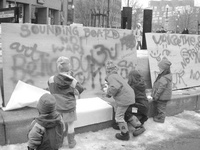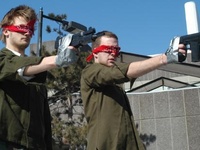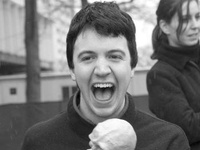Performers say there have been mixed—but strong—reactions from passersby to their feelings about PART and the war.
McGregor points to two students who discussed going to an anti-war rally that PART publicized. And Cozzens notes that a man with a bullhorn cursed at the group from a Holworthy window.
While PART’s work is not modelled on any other movement past or present, it does recall the “guerilla theater” that developed in protest of the Vietnam War—which also tried to harness the power of art in changing public sentiment.
“It’s easy to ignore numbers, but it’s art that stays with us—an image, a tune—and in the end may force us to confront our reality,” McGregor says.
Battle of the Brushes
While theater has quickly taken the stage in protesting, visual artists are taking longer to pick up their paintbrushes and clay.
But their involvement shouldn’t come as a surprise, Selvage says, noting a funny coincidence.
“I realized that the words ‘stop war,’ when they are deflected and land in reverse—it spells ‘raw pots,’” she says. “[The war] will obviously have an effect on future work of artists. In many cases, this takes a long time to absorb.”
And indeed most undergraduate visual artists, hurrying to finish theses, have not focused on creating full-fledged exhibitions of protest art critical of U.S. policy.
In these early stages, the art has taken the form of soundboards in hallways, open-mics in dining halls and banners and picket signs carried in rallies.
Visual and Environmental Studies Head Tutor Paul Stopforth says it will take more time for the war to filter into painting and sculpture and other media.
“Making art requires a level of reflection,” Stopforth says.
But Stopforth says there hasn’t been time for a thoughtful movement to progress.
“There isn’t clearly a body of work directed to social and political issues,” Stopforth said. “But there certainly are individuals who are who are conscious of it and introduce aspects of it in their work.”
He described one student in particular: “He is dealing with ruins, which until recently had a kind of romantic quality to them. And they have shifted toward something which is in a sense a lot more sinister: the presence of clouds caused by fire or smoke or explosions.”
Read more in Arts
Season Opens with World Premiere















